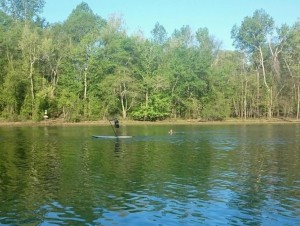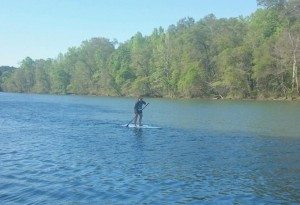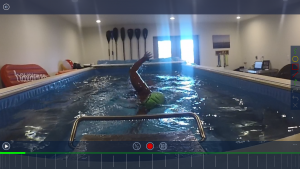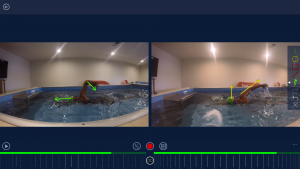No Man Steps in the Same River Twice: Heraclitus of Ephesus
This past weekend the US National Whitewater Center held the Tuck Fest – over 3 days you could compete, learn, demo, or just watch and relax. There was an impressive schedule of races from mountain biking, to trail running of various distances, to flatwater kayak and SUP, to whitewater paddling, open water swimming and obstacle courses just to name a few. What an opportunity to be outside on a perfect North Carolina spring weekend.
I chose to do the 1.5km open water swim – Swim the Ford – and the 3 mile SUP race – they were on the schedule one after the other and shared in parts the same body of water.
I was intrigued by the name of the swim and found the following facts to satisfy my curiosity. The ‘Tuck’ name of the festival comes from the Tuckaseegee Ford and Trail. The Ford is the first known crossing point along the Catawba River, traveled by Native Americans and settlers, to allow them to access the Tuckaseegee Trail and Trading Path also known as Charlotte. Sadler Island right off the dock where we swam, and paddled around, is a reminder of the Ford crossing and what a significant piece of NC history the Ford holds.
I did ponder the history during the swim and SUP races. What was it like to cross the Ford in those days? How did they navigate the water and currents?
River conditions can present challenges to anyone trying to navigate them. During my races I was reading the river environment as a part of my strategy to find the most direct route that had the greatest ease for speed. Where did I find it?
The swim was a rectangular course that first went upstream about 175m, a left turn for a short 25m stretch into another left turn and then a long 350m downstream stretch, another left turn into a short 25m stretch and then left turn again for the final 175m upstream. This was then repeated to make the 1.5k.
Once I had seen the layout of the course I was thinking about the best way to navigate the swim. I went with being just outside the direct line on the upstream stretches – shallower water has slower water flow, and then keeping more in the middle and deeper part of the river during the longer downstream stretch – the further away the water from the river bottom, the faster the current. This placement seemed to work well and I finished second overall female and third overall.

After a quick 10 minute break the SUP race was going to begin. The wind had picked up a little as the course was briefed. We were to paddle around Sadler Island twice. The first 650 yards was upstream into the wind, then a sharp left turn into 1300 yards or so downstream stretch, then a turn into a meandering stretch of about 650 yards back to the dock. This was repeated twice to make the 3 mile course. I took a similar approach from the swim into the SUP. In addition, in the meandering section reading the water flow to allow for faster flowing water around the outside curve of the meander and slower water in the inside curve. This approach also worked well and I finished fourth overall women and seventh overall.

There is so much more to consider when open water swimming and paddling – the brain must be able to compute a lot of things simultaneously in the calmest of ways. This was just what I was considering with respect to water flow but I was also thinking about navigation checks to make sure I was on the best route, stroke technique – what was going well, what did I need to adjust and stroke rate – was this sustainable and able to allow for consistent pacing. And the most important aspect – to remain calm mentally – SwimEQ – so that I could consider all of the above.
Coach Dinah


 The swimmer could really feel a difference in her breathing moment on the left. She was able to detect her momentum continuing, and she was able to access the air with ease. As she continued to swim, some breathing moments were better than others. This is totally normal, but her increased awareness and feel, allowed her to detect the less integrated breaths, and make adjustments to the next breathing cycle.
The swimmer could really feel a difference in her breathing moment on the left. She was able to detect her momentum continuing, and she was able to access the air with ease. As she continued to swim, some breathing moments were better than others. This is totally normal, but her increased awareness and feel, allowed her to detect the less integrated breaths, and make adjustments to the next breathing cycle.
